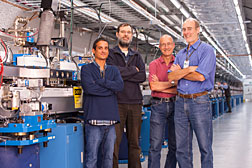- Number 371 |
- September 10, 2012
World's most powerful x-ray laser beam refined to scalpel precision

Part of the SLAC team that worked on
self-seeding is shown alongside the hardware
in the LCLS Undulator Hall. From left:
John Amann, Henrik Loos, Jerry Hastings and
Jim Welch. Photo by Matt Beardsley,
SLAC National Accelerator Laboratory
With a thin sliver of diamond, scientists at DOE’s SLAC National Accelerator Laboratory have transformed the world’s most powerful X-ray laser, the Linac Coherent Light Source, into an even more precise tool for exploring the nanoworld. The new technique focuses laser pulses to higher intensity in a much narrower band of X-ray wavelengths, and may enable experiments that were not possible before.
Laboratories around the world are already planning to incorporate this important advance into their own X-ray laser facilities. Like trading a hatchet for a scalpel, it will give researchers more control in studying and manipulating matter at the atomic level and will deliver sharper images of materials, molecules and chemical reactions.
“The more control you have, the finer the details you can see,” said Jerry Hastings, a SLAC scientist and co-author of a report on the research that appeared Aug. 12 in Nature Photonics. “People have been talking about self-seeding for nearly 15 years.”
In self-seeding, a sliver of diamond filters the laser beam to a single X-ray color, which is then amplified. This system had been proposed in 2010 by researchers at the European XFEL and DESY research centers in Germany. When a team from SLAC and Argonne National Laboratory built it at LCLS, Hastings said, “we were surprised by how simple, robust and cost-effective the engineering turned out to be.”
The method has the potential to produce X-ray pulses with significantly higher intensity than the LCLS can now provide. The increased intensity would allow scientists to probe deep into complex materials to help answer questions about exotic substances like high-temperature superconductors or intricate electronic states like those found in topological insulators.
The LCLS generates its laser beam by accelerating bunches of electrons to nearly the speed of light and setting them on a zigzag path in devices called undulators. This forces the electrons to emit X-rays, which are gathered into brilliant laser pulses that scan samples in quadrillionths of a second.
Without self-seeding, these X-ray laser pulses contain a range of wavelengths (or colors) in an unpredictable pattern, not all of which experimenters can use. Until now, creating a narrower wavelength band at LCLS meant subtracting the unwanted wavelengths, resulting in a substantial loss of intensity.
Producing the narrower wavelength band is just the beginning. “The resulting pulses could pack up to 10 times more intensity when we finish optimizing the system and add more undulators," said Zhirong Huang, a SLAC accelerator physicist and co-author of the report, who has been a major contributor to the project.
LCLS has already begun accepting proposals to use self-seeding for future experiments, and the first tests of the system have generated intense excitement among scientists the world over. Representatives from other X-ray laser facilities, including Swiss FEL, SACLA in Japan and the European XFEL, came to help and learn how to implement it at their own sites.
According to Paul Emma, a co-author who was a key figure in the original commissioning of the LCLS and in implementing self-seeding, “the entire group of observers was smiling from ear to ear." Emma, now working at Lawrence Berkeley National Laboratory, has a history of making tough jobs look easy, but he would only say, "I was very happy to see it work."
The team included collaborators from the Technical Institute for Superhard and Novel Carbon Materials in Troitsk, Russia, which supplied the diamond filter, and Argonne National Laboratory, which designed the vacuum chamber to house it and the precision motion controls to adjust it. The research was supported by the DOE’s Office of Science.
[Andy Freeberg, 650-926-4359,
afreeberg@slac.stanford.edu]
